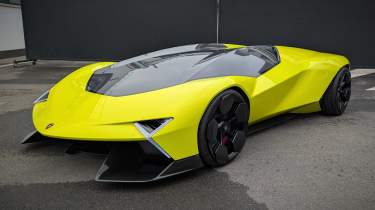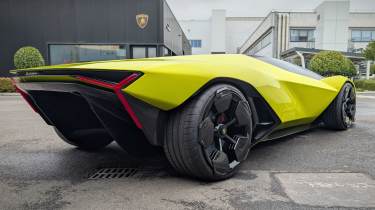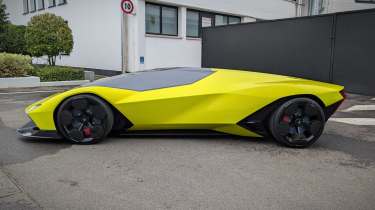Lamborghini Manifesto is a glimpse into an elegant future for Sant’Agata’s supercars
Very much a design study and not a preview for a future model, Manifesto is an exploration of ideas yet to be realised
Lamborghini has revealed its Manifesto design study. Doing exactly what it says on the tin, this is less a preview of a specific supercar waiting in the wings and more an exercise in design language foreshadowing, not to mention a celebration of Lamborghini Centro Stile’s 20th birthday. You won’t see a production Manifesto on the road in 2027, but cars to come from Lamborghini will wear design traits first explored on this most fantastical of concept cars.
Revealed during the 20th anniversary Centro Stile celebration at its Sant'Agata Bolognese home, Centro Stile Director Mitja Borkert described the car as ‘pure sculpture’ and a ‘design manifesto’. In contrast to the recently revealed detail-laden Fenomeno hypercar or the Revuelto that’s all angles and edges, Manifesto is more about sprawling volumes and evolving lines – it’s a definite change of visual pace for the brand.
The lighting continues what we’ve seen on the Fenomeno with the more vertically oriented Y-shape motif. The triangular-shaped housing of the main unit at the front is almost reminiscent of the Aventador and Murciélago rather than the Revuelto.
The proportions are exaggerated as you would expect for a purely exploratory design model with an almost Valkyrie-like footprint. There are more contrasts that can be drawn with Aston Martin’s pivotal Newey-designed hypercar, too.
The rear of the Manifesto is an extreme taper (quite unlike the snub rear ends we’ve come to love Lamborghini supercars for) the underside of which is a sprawling venturi tunnel extending all the way under the car.
At the front, the usual bluff nose and prominent vents and splitters are replaced with flanking vents and enormous negative space in the middle feeding air under the car. It isn’t a fully realised device in terms of its aerodynamics obviously but these are the beginnings of a supercar that leans more on ground effect than Lamborghinis have tended to up to this point.
Obviously the packaging isn’t fully realised either. You can’t imagine an adequate door hinge being nestled ahead of those front wheels. Nor that the canopy's topography would be particularly easy or economical to productionise in glass. Nor that a V12 would fit at the heart of the Manifesto given how extreme the diffuser is.
Indeed, Borkert asserted during the presentation of the car that ‘there is no engine inside’ though the twelve vents atop the Manifesto’s sprawling deck are at least suggestive that this car has been conceived in the image of a flagship rather than junior Lamborghini supercar.
The Manifesto begins and ends here – there will be no production version. But here is a glimpse at what Centro Stile is exploring for future models from Sant’Agata. It joins a long and illustrious line of concepts and one-offs that now furnish Museo Lamborghini.
Its reveal crowned the Centro Stile 20th anniversary celebration at which past masters and once-directors of Centro Stile also appeared – Filippo Perini (desginer of the Aventador), Walter de Silva (former head of Volkswagen Group Design), among a number of figures from the design automotive design community at large.







